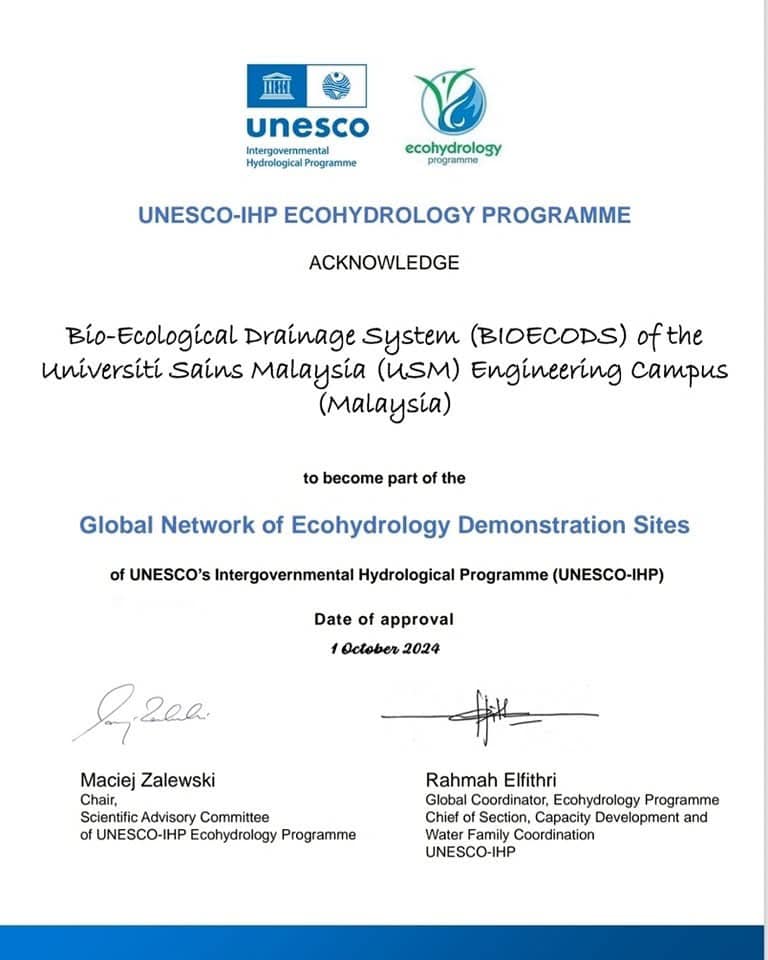BIOECODS AT ENGINEERING CAMPUS RECOGNIZED AS UNESCO ECOHYDROLOGY DEMONSTRATION SITE

Certificate of BIOECODS Recognition as a UNESCO Ecohydrology Demonstration Site 2024
The Bio-Ecological Drainage System (BIOECODS) at the Universiti Sains Malaysia (USM) Engineering Campus has been officially acknowledged by the UNESCO-IHP Ecohydrology Programme as part of the Global Network of Ecohydrology Demonstration Sites.
This prestigious recognition, dated 1 October 2024, positions BIOECODS among an elite global network committed to advancing ecohydrology as a science-based approach for sustainable water management. The designation was formally endorsed by Maciej Zalewski, Chair of the Scientific Advisory Committee of the UNESCO-IHP Ecohydrology Programme, and Rahmah Elfithri, Global Coordinator for the Ecohydrology Programme and Chief of Section, Capacity Development and Water Family Coordination at UNESCO-IHP.
BIOECODS, which stands for Bio-Ecological Drainage System, is a pioneering infrastructure developed at the USM Engineering Campus, Nibong Tebal, Penang. It integrates ecological principles into urban drainage to manage stormwater runoff in a way that protects and enhances water quality while supporting biodiversity.
Our highest appreciation goes to UNESCO-IHP for granting this recognition, as well as to Elfithri Rahmah for her significant role in this achievement. Of course, we must also acknowledge the Department of Irrigation and Drainage Malaysia (JPS) and its Bahagian Saliran Mesra Alam, which has been a driving force and strong supporter in ensuring that the nation’s BIOECODS pilot project, established in 2001, remains robust to this day.
BIOECODS has had a significant impact on REDAC, particularly as the success of the system became one of the key factors leading to REDAC’s recognition as one of the Higher Education Centres of Excellence (HICoE) under the HICoE Service Niche Area in the field of Sustainable Urban Stormwater Management in 2014. Our highest appreciation goes to the Ministry of Higher Education for their trust and continuous support towards REDAC over the years.
Not to be forgotten are the early pioneers, such as Datuk Paduka Ir. Hj Keizrul Abdullah, Prof. Dato’ Dr. Nor Azazi Zakaria, Prof. Aminuddin Ab Ghani, and many others who have sacrificed and contributed immensely to BIOECODS. BIOECODS applies the concepts outlined in the Manual Saliran Mesra Alam (MSMA), which continues to be used as one of the key guidelines in Malaysia. Special thanks also to the Humid Tropics Centre Kuala Lumpur, under the leadership of Dato’ Ratna Rajah Sivapiragasam and the team, for their guidance and commitment in realizing this prestigious designation.
Since its development, BIOECODS has served as a living laboratory and demonstration site for students, researchers, practitioners, and policymakers in Malaysia and beyond. It demonstrates how interdisciplinary approaches combining hydrology, ecology, engineering, and community engagement can effectively address pressing challenges such as water pollution, urban flooding, and habitat degradation.
The system features a series of interconnected wetlands, detention ponds, vegetated swales, and biofiltration cells that mimic natural hydrological processes. These components function synergistically to attenuate peak flows, filter pollutants, and support diverse plant and animal life. In addition, the site has become a focal point for environmental education and awareness, regularly hosting study visits, workshops, and training sessions for various stakeholders.
Without the unwavering trust and support of Universiti Sains Malaysia (USM), USM Engineering Campus, and REDAC researchers, this achievement would not have been possible. The acknowledgement from UNESCO-IHP not only affirms the scientific and practical value of the system but also opens new opportunities for international collaboration, knowledge exchange, and capacity building.
This recognition also aligns with Malaysia’s commitment to the United Nations Sustainable Development Goals (SDGs), particularly Goal 6 on Clean Water and Sanitation, Goal 11 on Sustainable Cities and Communities, and Goal 13 on Climate Action. By showcasing BIOECODS as a demonstration site, USM contributes directly to these global targets while providing a local solution adaptable to tropical urban environments.
With this official designation, BIOECODS joins other demonstration sites worldwide under UNESCO’s Global Network of Ecohydrology Demonstration Sites. Moving forward, USM and REDAC plan to leverage this recognition to promote research, education, and policy dialogues on ecohydrology and sustainable urban drainage systems, ensuring that BIOECODS continues to serve as a model for innovative, science-based solutions for water and ecosystem management.